space cadet
SENIOR MEMBER
The secret war fought by US Navy's most capable hunter-killer submarine
24 Nov, 2019 1:51pm
8 minutes to read
Play Video
USS Jimmy Carter transits the Hood Canal. Video / U.S. Navy
news.com.au
By: Jamie Seidel
Unexplained damage. The Jolly Roger combat-kill flag. A Presidential Citation for courage under fire. Just what has the United States' most advanced attack submarine been up to?
Everything a submarine does is supposed to go unseen.
They are built to dive deep and run silent.
Stealth is their thing, to sneak up on an unexpecting enemy or to stay safely hidden.
ADVERTISEMENT
So the top-secret nature of their work is to be expected.
But a few tantalising clues can, and do, slip out.
In September 2017, the submarine USS Jimmy Carter nosed into its home port in the West Coast state of Washington.
It was an ordinary scene. But the flag it was flying was not.
The black-and-white Jolly Roger has special meaning for submariners. It's a tradition started by the British in World War I.
It represents a combat victory.
Since then, the world has learnt nothing more.
But the USS Jimmy Carter's short history is studded with similar clues pointing to the secret war it has been fighting.
ADVERTISEMENT
ONE OF A KIND
The USS Jimmy Carter is the United States Navy's most capable hunter-killer submarine.
It's a one-off.
Completed in 2005, it is a heavily modified version of the Seawolf-class of attack submarine.
Only two others exist because of their extraordinary $US3 billion ($A4.3 billion) price tag.
They were built to dive extraordinarily deep. We don't know how far.
They were built to sprint silently while submerged. Exactly how fast remains top secret.
But the USS Jimmy Carter was lengthened. It has an extra module inserted in its hull.
Initially, the US Navy only described this expensive modification a 30.5m long internal space for experimental "non-traditional" payloads.
We now know what "non-traditional" meant. It was a multi-mission garage. It can carry, launch and control semi-autonomous drones into the air or water, as well as small craft for 50 special operations Seal commandos and deep-sea divers.
A new advanced communications mast was built into the protruding sail on its deck to support this sophisticated equipment. This is capable of high-speed, low-profile, data exchange.
The big submarine has one other feature: independent propulsion modules recessed into its bow and stern. These can precisely, and quietly, nudge the sub into a precise position or through a deadly obstacle course.
So if there is an essential but dangerously delicate espionage job to be done, the USS Jimmy Carter is likely to be on the case.
We know it has been carrying out classified marine research and technology trials. Just not on what.
We can guess it has also been up to undersea surveillance, that's what hunter-killer submarines do.
But the USS Jimmy Carter must have been up to something special to win a US Presidential Citation.
COURAGE UNDER FIRE
The first hint this unique submarine was up to something unusual came in 2013.
The boat and its 150 crew slipped out of its home port of Bangor, Washington, with little fanfare. That's what submarines do.
What does not usually happen is for it to unexpectedly reappear two months later, damaged, motoring into the Pearl Harbour naval base in Hawaii.
What had it been up to?
Publicly available information is sparse, as is to be expected.
The USS Jimmy Carter's heavily redacted Command Operations Report, obtained by the War is Boring blog under freedom of information laws, only refers to the operation as "Mission 7".
"Performed under a wide range of adverse and extremely stressful conditions without external support, this deployment continued USS Jimmy Carter's tradition of excellence in pursuit of vital national security goals," it states.
And this mission was adverse, stressful and lonely enough to win the submarine's crew a Presidential Unit Citation.
This ribbon was instigated after the attack on Pearl Harbour in World War II for a unit (such as a ship, submarine or commando platoon) to recognise "extraordinary heroism in action against an armed enemy".
It must also "display such gallantry, determination, and esprit de corps in accomplishing its mission under extremely difficult and hazardous conditions so as to set it apart from and above other units participating in the same campaign".
From this, we can infer that the USS Jimmy Carter – in peacetime – had engaged in operations in the Pacific or Arctic Ocean against an armed opponent under extremely hazardous conditions. And succeeded.
The extent and nature of the damage the submarine suffered has never been detailed.
JOLLY ROGER
The USS Jimmy Carter slipped beneath the news cycle for several years before surfacing again in April 2017 with another mystery.
On the surface, everything seemed ordinary.
The secretive submarine slipped quietly back into its home port.
Attendant tugboats nosed about. Key command personnel kept watch from atop its small tower. The Stars and Stripes fluttered proudly.
But there was a profoundly significant black-and-white flag fluttering behind it.
It was the Jolly Roger. And, in submariner circles, that swashbuckling symbol means victory in combat.
The use of the Jolly Roger began with the Royal Navy in World War I. It was a tongue-in-cheek response to disparaging remarks by an admiral who had labelled submariners "pirates". They were "underhanded, unfair and damned un-English!".
Soon, sailors were stitching symbols on to it as an in-your-face record of the type of "kill" they had achieved. A coloured line or ship silhouette would represent a type of ship sunk. A small "pee-pot depicted an enemy boat destroyed. A dagger marked secret cloak-and-dagger operations. A lifebuoy symbolised a rescue.
The tradition persists. During the Falklands War of 1982, the Royal Navy nuclear attack submarine HMS Conqueror returned to its home port of Faslane in Scotland flying the Jolly Roger after sinking the Argentinian cruiser General Belgrano.
In more recent times, tomahawk axes have come to represent cruise missile strikes against Libya, Syria and Iraq.
This was not to be the only time the USS Jimmy Carter was spotted flying the battle victory flag. It did so again while returning to port just months later, in September 2017.
Both sets of pictures were officially released by the US Navy's public relations corps. But no explanation for either use of the Jolly Roger was offered. And none of the pictures gave us a clear look at the kind of mission symbols denoting its victories.
SILENT SERVICE
So, what has the USS Jimmy Carter been up to? We don't know.
But we can speculate.
It could be snooping on North Korea, China and Russia. It has reason to do so. There's Beijing's artificial island fortresses in the South China Sea. There's Pyongyang's rogue nuclear missile program. And there's Moscow's testing of its growing range of experimental weaponry.
A submarine with these capabilities could be used to place surveillance devices, or perhaps even dormant mines, in narrow choke-point shipping channels. This would entail considerable risk of discovery and collision.
It could secretly deliver and recover secret agents and commandos from hostile shores.
It could manoeuvre dangerously close to other vessels, intercepting and recording sound and electronic emissions. It could even photograph or scan secret features, such as propeller types and shapes.
It could move about in a competitor's most secure harbours, mapping their features in fine detail and recording activities.
It could locate – and tap into – otherwise unreachable underwater fibre-optic cable networks.
It could deploy – or interrupt – undersea anti-submarine sensor networks. It could lay its own.
But, mostly, submarines are supposed to be where there is trouble.
When North Korea unleashed a barrage of artillery fire against a South Korean island in November 2010, the USS Jimmy Carter launched drones into the air to observe its effects and locate the guns.
TROUBLED WATERS
The USS Jimmy Carter has been in the news again recently. This time for less auspicious reasons.
It's joined the growing ranks of US Pacific Fleet ships punished for poor performance.
After a string of fatal collisions between its destroyers and cargo ships, the US Navy has been cracking down hard on the navigation skills and general competence of its command staff.
The secret attack submarine's second-in-command didn't make the grade.
"The executive officer of USS Jimmy Carter, Lt. Cmdr. Jonathan Cebik, has been relieved due to a loss of confidence in his personal judgment," the Navy said in an August statement.
He's been reassigned to a desk job.
A spokeswoman for the Pearl Harbor-based Pacific Fleet Submarine Force said no additional information about Lt Cmdr Cebik's removal would be supplied.
The impact on the submarine, its crew or its operations also remain unknown.
But it may make it harder for the USS Jimmy Carter to live up to its predecessor.
This US Navy vessel won the most Presidential Unit Citations ever.
It was the USS Parche. Built in 1973, it was a Sturgeon-class hunter-killer submarine that also had been modified for special operations. It's top-secret career, which ended just months before the USS Jimmy Carter entered service, earned it nine citations.
24 Nov, 2019 1:51pm
8 minutes to read
Play Video
USS Jimmy Carter transits the Hood Canal. Video / U.S. Navy
news.com.au
By: Jamie Seidel
Unexplained damage. The Jolly Roger combat-kill flag. A Presidential Citation for courage under fire. Just what has the United States' most advanced attack submarine been up to?
Everything a submarine does is supposed to go unseen.
They are built to dive deep and run silent.
Stealth is their thing, to sneak up on an unexpecting enemy or to stay safely hidden.
ADVERTISEMENT
So the top-secret nature of their work is to be expected.
But a few tantalising clues can, and do, slip out.
In September 2017, the submarine USS Jimmy Carter nosed into its home port in the West Coast state of Washington.
It was an ordinary scene. But the flag it was flying was not.
The black-and-white Jolly Roger has special meaning for submariners. It's a tradition started by the British in World War I.
It represents a combat victory.
Since then, the world has learnt nothing more.
But the USS Jimmy Carter's short history is studded with similar clues pointing to the secret war it has been fighting.
ADVERTISEMENT
ONE OF A KIND
The USS Jimmy Carter is the United States Navy's most capable hunter-killer submarine.
It's a one-off.
Completed in 2005, it is a heavily modified version of the Seawolf-class of attack submarine.
Only two others exist because of their extraordinary $US3 billion ($A4.3 billion) price tag.
They were built to dive extraordinarily deep. We don't know how far.
They were built to sprint silently while submerged. Exactly how fast remains top secret.
But the USS Jimmy Carter was lengthened. It has an extra module inserted in its hull.
Initially, the US Navy only described this expensive modification a 30.5m long internal space for experimental "non-traditional" payloads.
We now know what "non-traditional" meant. It was a multi-mission garage. It can carry, launch and control semi-autonomous drones into the air or water, as well as small craft for 50 special operations Seal commandos and deep-sea divers.
A new advanced communications mast was built into the protruding sail on its deck to support this sophisticated equipment. This is capable of high-speed, low-profile, data exchange.
The big submarine has one other feature: independent propulsion modules recessed into its bow and stern. These can precisely, and quietly, nudge the sub into a precise position or through a deadly obstacle course.
So if there is an essential but dangerously delicate espionage job to be done, the USS Jimmy Carter is likely to be on the case.
We know it has been carrying out classified marine research and technology trials. Just not on what.
We can guess it has also been up to undersea surveillance, that's what hunter-killer submarines do.
But the USS Jimmy Carter must have been up to something special to win a US Presidential Citation.
COURAGE UNDER FIRE
The first hint this unique submarine was up to something unusual came in 2013.
The boat and its 150 crew slipped out of its home port of Bangor, Washington, with little fanfare. That's what submarines do.
What does not usually happen is for it to unexpectedly reappear two months later, damaged, motoring into the Pearl Harbour naval base in Hawaii.
What had it been up to?
Publicly available information is sparse, as is to be expected.
The USS Jimmy Carter's heavily redacted Command Operations Report, obtained by the War is Boring blog under freedom of information laws, only refers to the operation as "Mission 7".
"Performed under a wide range of adverse and extremely stressful conditions without external support, this deployment continued USS Jimmy Carter's tradition of excellence in pursuit of vital national security goals," it states.
And this mission was adverse, stressful and lonely enough to win the submarine's crew a Presidential Unit Citation.
This ribbon was instigated after the attack on Pearl Harbour in World War II for a unit (such as a ship, submarine or commando platoon) to recognise "extraordinary heroism in action against an armed enemy".
It must also "display such gallantry, determination, and esprit de corps in accomplishing its mission under extremely difficult and hazardous conditions so as to set it apart from and above other units participating in the same campaign".
From this, we can infer that the USS Jimmy Carter – in peacetime – had engaged in operations in the Pacific or Arctic Ocean against an armed opponent under extremely hazardous conditions. And succeeded.
The extent and nature of the damage the submarine suffered has never been detailed.
JOLLY ROGER
The USS Jimmy Carter slipped beneath the news cycle for several years before surfacing again in April 2017 with another mystery.
On the surface, everything seemed ordinary.
The secretive submarine slipped quietly back into its home port.
Attendant tugboats nosed about. Key command personnel kept watch from atop its small tower. The Stars and Stripes fluttered proudly.
But there was a profoundly significant black-and-white flag fluttering behind it.
https://twitter.com/IanJKeddie/status/907759347635245056
USS Jimmy Carter, 1 of the most secretive subs in the USN, returns to home port flying the Jolly Roger flag - indicating operational action.
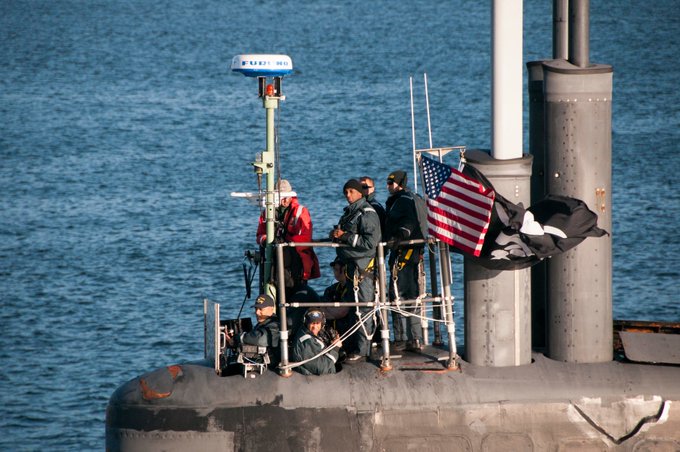
I put together a guide to the tradition of flying the Jolly Roger from submarines
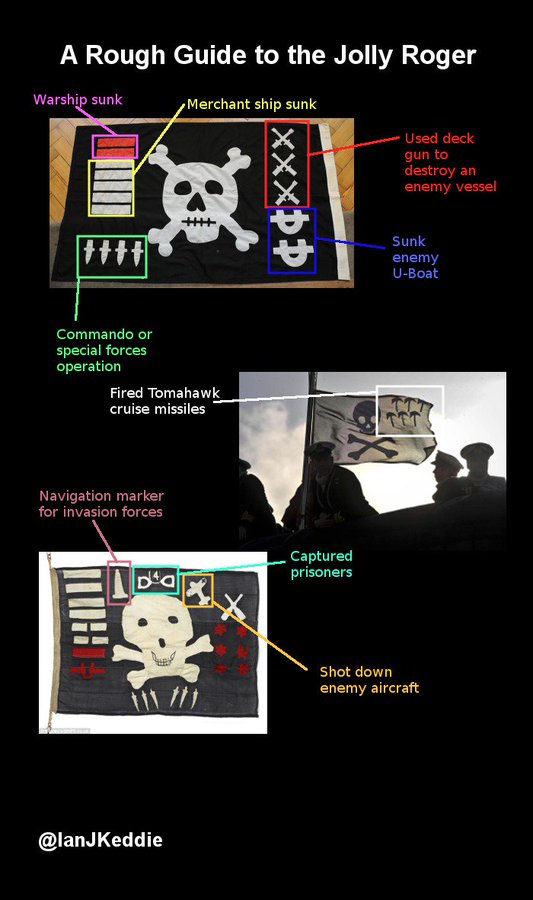
https://twitter.com/intent/like?tweet_id=908045395552595969
It was the Jolly Roger. And, in submariner circles, that swashbuckling symbol means victory in combat.
The use of the Jolly Roger began with the Royal Navy in World War I. It was a tongue-in-cheek response to disparaging remarks by an admiral who had labelled submariners "pirates". They were "underhanded, unfair and damned un-English!".
Soon, sailors were stitching symbols on to it as an in-your-face record of the type of "kill" they had achieved. A coloured line or ship silhouette would represent a type of ship sunk. A small "pee-pot depicted an enemy boat destroyed. A dagger marked secret cloak-and-dagger operations. A lifebuoy symbolised a rescue.
·
https://twitter.com/IanJKeddie/status/908673945846632448
A closer look at the symbols on the #JollyRoger flown by #USSJimmyCarter: My attempt to decipher, most likely a type of 'cable tapping'
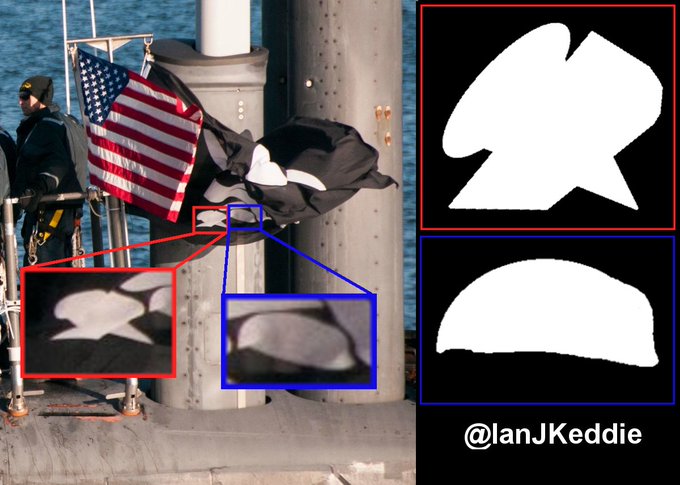
As many have pointed out, #USSJimmyCarter also flew #JollyRoger back in April. Flags appear to be different, I put together a comparison
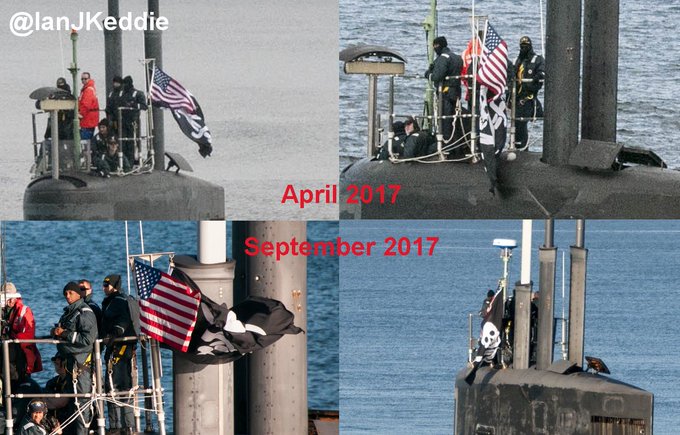
https://twitter.com/intent/like?tweet_id=908674979138502661
The tradition persists. During the Falklands War of 1982, the Royal Navy nuclear attack submarine HMS Conqueror returned to its home port of Faslane in Scotland flying the Jolly Roger after sinking the Argentinian cruiser General Belgrano.
In more recent times, tomahawk axes have come to represent cruise missile strikes against Libya, Syria and Iraq.
https://twitter.com/IanJKeddie/status/907759347635245056
USS Jimmy Carter, 1 of the most secretive subs in the USN, returns to home port flying the Jolly Roger flag - indicating operational action.

A closer look at the symbols on the #JollyRoger flown by #USSJimmyCarter: My attempt to decipher, most likely a type of 'cable tapping'

This was not to be the only time the USS Jimmy Carter was spotted flying the battle victory flag. It did so again while returning to port just months later, in September 2017.
Both sets of pictures were officially released by the US Navy's public relations corps. But no explanation for either use of the Jolly Roger was offered. And none of the pictures gave us a clear look at the kind of mission symbols denoting its victories.
SILENT SERVICE
So, what has the USS Jimmy Carter been up to? We don't know.
But we can speculate.
It could be snooping on North Korea, China and Russia. It has reason to do so. There's Beijing's artificial island fortresses in the South China Sea. There's Pyongyang's rogue nuclear missile program. And there's Moscow's testing of its growing range of experimental weaponry.
A submarine with these capabilities could be used to place surveillance devices, or perhaps even dormant mines, in narrow choke-point shipping channels. This would entail considerable risk of discovery and collision.
It could secretly deliver and recover secret agents and commandos from hostile shores.
It could manoeuvre dangerously close to other vessels, intercepting and recording sound and electronic emissions. It could even photograph or scan secret features, such as propeller types and shapes.
It could move about in a competitor's most secure harbours, mapping their features in fine detail and recording activities.
It could locate – and tap into – otherwise unreachable underwater fibre-optic cable networks.
It could deploy – or interrupt – undersea anti-submarine sensor networks. It could lay its own.
But, mostly, submarines are supposed to be where there is trouble.
When North Korea unleashed a barrage of artillery fire against a South Korean island in November 2010, the USS Jimmy Carter launched drones into the air to observe its effects and locate the guns.
https://twitter.com/kadonkey/status/1112057476139151360
The Sea Wolf-class attack submarine USS Jimmy Carter SSN 23 sits moored in the Magnetic Silencing Facility at Naval Base Kitsap Bangor for her first deperming treatment. The deperming process reduces a ships electromagnetic signature as she travels through the water. 2006.Navy
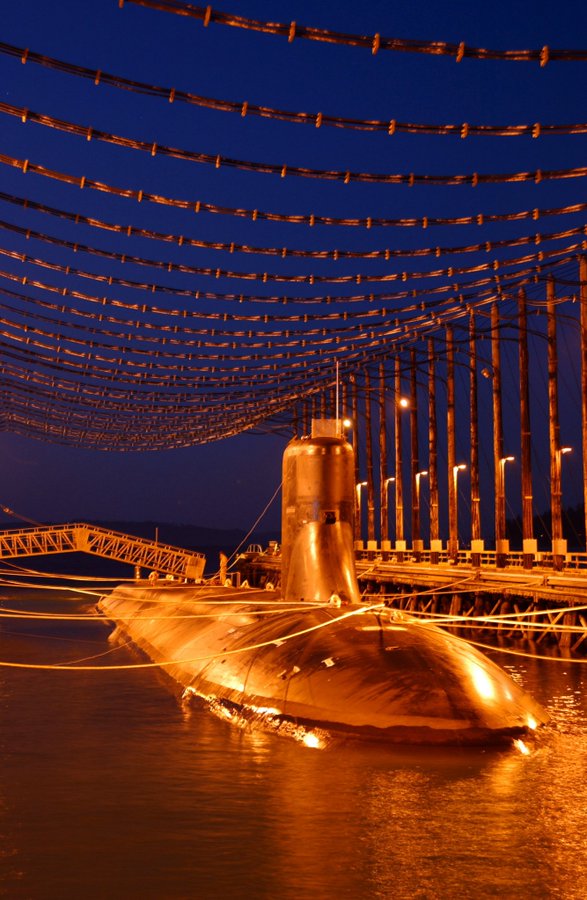
TROUBLED WATERS
The USS Jimmy Carter has been in the news again recently. This time for less auspicious reasons.
It's joined the growing ranks of US Pacific Fleet ships punished for poor performance.
After a string of fatal collisions between its destroyers and cargo ships, the US Navy has been cracking down hard on the navigation skills and general competence of its command staff.
The secret attack submarine's second-in-command didn't make the grade.
"The executive officer of USS Jimmy Carter, Lt. Cmdr. Jonathan Cebik, has been relieved due to a loss of confidence in his personal judgment," the Navy said in an August statement.
He's been reassigned to a desk job.
A spokeswoman for the Pearl Harbor-based Pacific Fleet Submarine Force said no additional information about Lt Cmdr Cebik's removal would be supplied.
The impact on the submarine, its crew or its operations also remain unknown.
But it may make it harder for the USS Jimmy Carter to live up to its predecessor.
This US Navy vessel won the most Presidential Unit Citations ever.
It was the USS Parche. Built in 1973, it was a Sturgeon-class hunter-killer submarine that also had been modified for special operations. It's top-secret career, which ended just months before the USS Jimmy Carter entered service, earned it nine citations.
